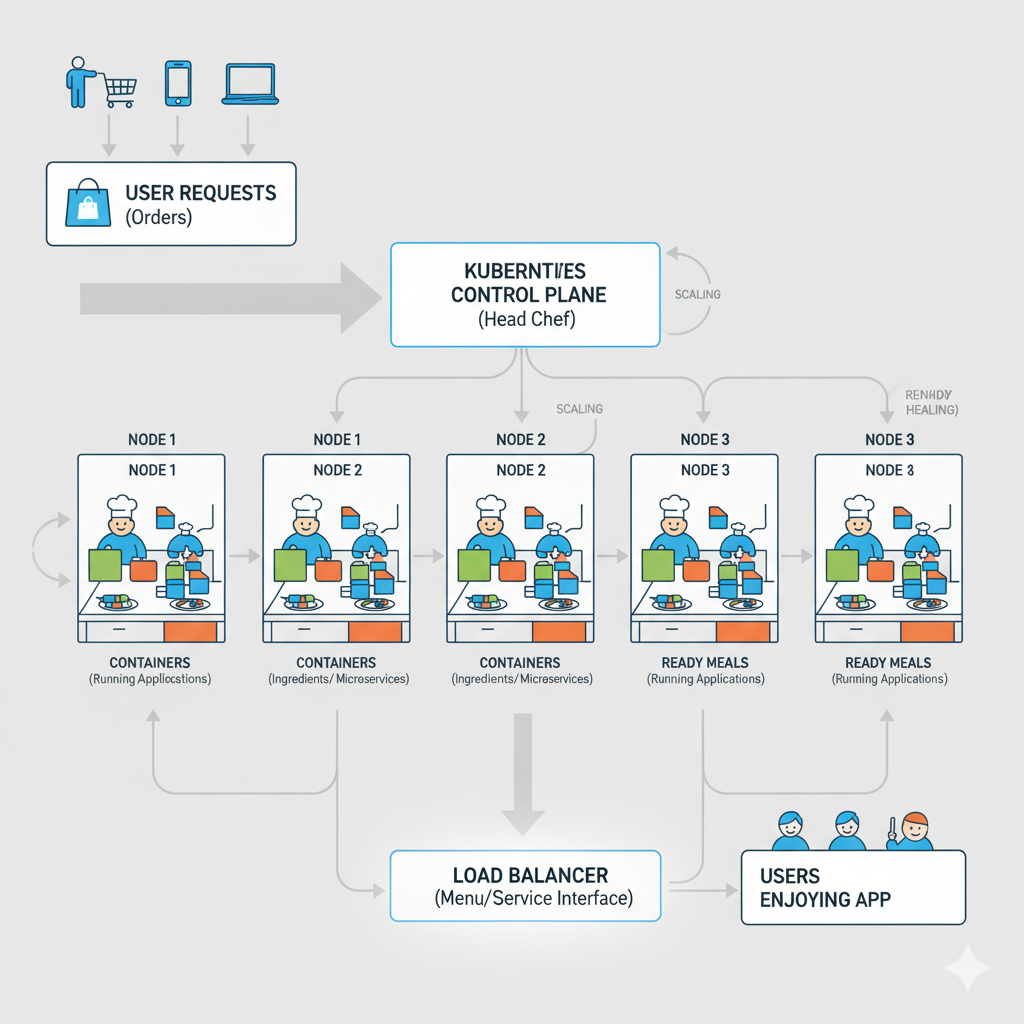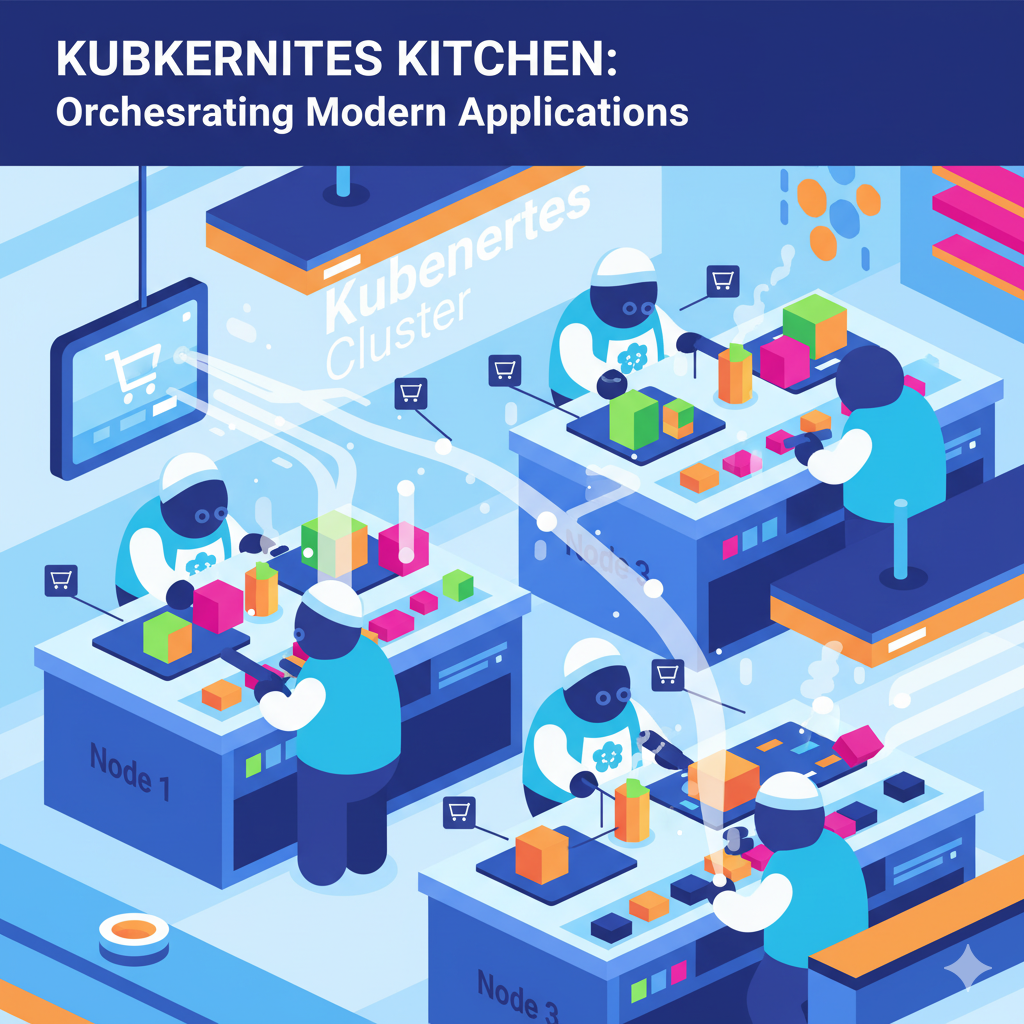Kubernetes or K8s is an open-source program that is capable of automatically starting, expanding, and maintaining container-based applications.
Containers are packages that have an application and all it requires to run, hence it acts the same on any computer. The containers are managed by Kubernetes. It decides where they run, ensures that they are fit and automatically replaces them in case of crashing. It simplifies difficult tasks like switching app levels on or off, updating components step-by-step, distributing work equally and utilizing available resources effectively. Kubernetes help businesses to make apps more reliable, efficient and capable of scaling. Consider Kubernetes your app manager. Rather than you beginning to spawn servers, monitor crashes, and distribute work, Kubernetes does all this automatically.
Hotel Kitchen Sample of Kubernetes.
Think of a large hotel restaurant which has hundreds of customers daily. The kitchen must do the food quickly, serve the staff, deal with the rushy times and serve all the dishes hot and delicious. This kitchen is able to illustrate the concepts of Kubernetes.
Kitchen as a Kubernetes Cluster.
Hotel kitchen is comparable to a Kubernetes cluster. There are numerous nodes in the cluster, as the kitchen has numerous cooking stations. One restaurant prepares starters, another prepares main dishes, yet another prepares desserts. Special containers (apps/services) are located in each station (node). When a station breaks down, the work is soon transferred to other stations by the manager. Kubernetes is no exception: when a node fails, it relocates the containers to the healthy nodes in order to keep the apps running.

Chefs as Pods
Food preparation is done by chefs in kitchen. A Kubernetes pod is a chef. A pod has all the ingredients to execute an app and so does the chef have all the ingredients and tools to execute a dish. Whenever there are numerous requests of the same dish, Kubernetes will generate numerous pods, just like the manager will employ numerous chefs to prepare the same dish simultaneously.
Orders as User Requests
Guests place orders. These requests are similar to user requests to an app. The kitchen should provide all the meals punctually. Kubernetes ensures that a request is sent to a service pod. Incidentally, when ten customers request pasta, Kubernetes spins up additional pods to the pasta service, as the manager would recruit more chefs to satisfy the demand.
Kitchen Manager as Kubernetes Controller.
The kitchen manager organizes work, quality control and replaces personnel, when necessary. The same is done by Kubernetes controllers. They maintain the system at the intended state and change failed pods. To illustrate, when the hotel decides that it always needs three chefs to cook pasta, the manager retains three chefs. Similarly, Kubernetes maintains a fixed number of replicas of the pods.
Container Image Ingredients.
Each meal requires something. Container images stored in a registry are called ingredients in Kubernetes. Once a chef begins cooking he/she picks the ingredients and proceeds with the recipe. Kubernetes downloads and executes container images in pods as the way to deploy applications.
Handling Rush Hours
There are peak times in the kitchen in terms of breakfast, lunch, and dinner. The manager recruits additional chefs of the most indemand dishes. Kubernetes adds or removes pods depending on traffic. Chefs have rest periods when demand dies. Kubernetes decreases running pods in order to save resources.
Intrastation.
With the aid of communication between stations, chefs can talk to one another to prepare full meals. Kubernetes relies on services in order to have pods communicate with each other in a reliable manner. The connection remains the same even in case a pod restarts.
Providing Meals as User Responses.
Dishes are carried to the guests by waiters. Ingress controllers are used to forward user requests to the appropriate pod in Kubernetes. Visitors obtain quick and dependable service and are not aware of who prepared their meal.
Monitoring Quality
The manager examines food prior to its departure. Kubernetes monitors the health of the pods and recreates those that fail. This maintains reliability and consistency of the app to the users.
Continuous Updates
Hotels change menus or introduce new dishes. Kubernetes allows rolling updates so that the new versions of apps are rolled out without downtime. Visitors continue receiving meals as the kitchen continues to add new dishes seamlessly.
Kubernetes is like a hotel kitchen manager to apps.
- Kitchen = cluster,
- chefs = pods,
- orders = user requests,
- ingredients = container images,
- manager = Kubernetes controllers,
- waiters = ingress controllers.
Using Kubernetes, hotels will be able to manage rush hours, maintain quality, and scale resources effectively and serve customers without any inconveniences. On the same note, businesses are able to operate applications in a dependable way, on-demand scale, and keep users happy.


